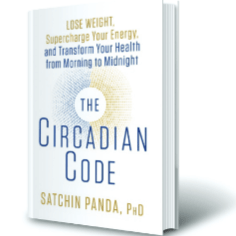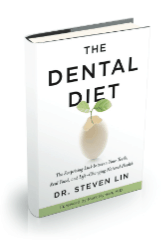by Pat Mc Bride, MA, RDA, CCSH
The Circadian Code
 Ask most people about their circadian clock and they will tell you it has “something to do with sleep.” As dental and sleep medicine clinicians we are increasingly tasked with educating our patients on the value of healthy lifestyle, eating, and sleeping habits.
Ask most people about their circadian clock and they will tell you it has “something to do with sleep.” As dental and sleep medicine clinicians we are increasingly tasked with educating our patients on the value of healthy lifestyle, eating, and sleeping habits.
The negative impact of imbalanced systems in our environment and bodies now reaches far beyond the risks of periodontal disease and tooth decay to include overall functioning and sleep. In The Circadian Code, the science behind the 24 hour circadian cycle is revealed by illustrating how the timings of our day (when we eat, sleep, exercise, work) are more crucial to our overall health and longevity than we ever thought before.
Dentists are often the one provider who spends more minutes per appointment with patients than just about any other medical practitioner. In that capacity, they become uniquely qualified to observe how a patient’s daily schedules may be out of sync with their circadian rhythms, which in turn affords him or her the opportunity to educate and help “fix” what may be wrong.
The world of molecular and circadian science are delivered to the public in this very engaging and readable book by Satchin Panda, PhD, who emphasizes the importance of timing in our bodies and environment. He states simply that “everything in our bodies cannot happen at once.” The body was not designed to be awake and asleep at the same time and is set to operate on a 24 hour rhythm cycle. This has been the case for millennia, and modern culture has disrupted the body’s cycles and its rhythmic connection to the 24 hour day. The circadian rhythm, he explains, is controlled by clocks present in every cell which tell the brain when to sleep, tell the gut to digest food optimally, and ultimately tell the heart to pump more or less blood to keep us alive.
Every single cell in the human body, hormones, brain chemicals, digestive enzymes etc., are pre-programmed genetically to peak at one point in the day and trough (literally gas out) at another. Without this clock the business of sleep, which is tasked with resting and repairing all bodily systems, cannot function as it should. Poor sleep is much more than a bad headache for some people, it is actually contributing to the shortening of lifespan, reduced quality of life and exacerbation of serious disease processes including sleep apnea.
Dr. Panda outlines in detail the circidian cycle, why it is important, how it works well, and ultimately how it fails to work properly as influenced by a host of factors such as food intake, lifestyle habits, no exercise or exercising at the wrong time of the day and social environmental factors such as exposure to too much light before bed or not enough during the day. While the book focuses heavily on weight gain issues caused by improper eating too late in the day, it lays out a program clinicians and hygienists can easily present during exam and hygiene appointments to patients who complain of weight gain, failed dieting or yo-yo swings in weight, fatigue, mood issues, and ultimately poor or fragmented sleep.
Cracking the door into an individual’s daily cycle may help you save a life, or at the very least change one. Dr. Panda’s easy-to-implement lifestyle modifications, such as restricted eating times during the day and exercising in the morning, offer concrete examples of ways in which our patients can reverse ailments like diabetes, cancer, and dementia, as well as microbiome conditions we all associate with sleep apnea such as acid reflux, heartburn and irritable bowel disease. Something as simple as eating earlier in the day can align gut rhythms and improve overall health and wellbeing.
As we look at sleep disorders in our patients we now have another educational tool to help them assess their own circadian cycles and individual habits so they can work to “reset their clocks.” You as their dental and sleep medicine provider are uniquely situated to influence and collaborate with your patients to improve their health, sleep, and wellbeing while empowering them to make small daily changes which lead to very big improvements in their lives.
The Dental Diet
 I have to admit, another book about diet, any diet, usually leaves me cold. We all know that diet refers to weight loss in most people’s minds, but in reality diet is really about what, when and how we eat, not just weight loss. So, when a copy of Steve Lin’s The Dental Diet landed on my desk recently I thought – “must be more about sugar and decay”…I couldn’t have been more wrong! Every dental office in the country needs to have this book in the waiting room. T
I have to admit, another book about diet, any diet, usually leaves me cold. We all know that diet refers to weight loss in most people’s minds, but in reality diet is really about what, when and how we eat, not just weight loss. So, when a copy of Steve Lin’s The Dental Diet landed on my desk recently I thought – “must be more about sugar and decay”…I couldn’t have been more wrong! Every dental office in the country needs to have this book in the waiting room. T
he more I read, the more I realized that the general public is constantly fed volumes of inaccurate information about nutrition. The is no denying that 42% of all kids have tooth decay, and at least 50% of all adults have periodontal disease in this country. I would hazard to guess that these numbers are escalating with the current pandemic of type II diabetes, heart disease, periodontitis and sleep apnea.
Deftly and without pretense, Dr. Lin teaches the reader that yes, in dental school he learned how to treat the issues of dental decay and periodontal disease but, it wasn’t until he came upon the seminal work of Weston A. Price that he realized the mouth is quite literally the “gateway to the entire body.” He could now prevent many of the issues he was treating people for.
Lin explains quite simply that food choices literally shape our faces. Crooked teeth are not caused by genetics, but rather by poor nutrition. Epigenetics, the process of the way genes express themselves, makes much more of an impact on health than the genes themselves. The foods individuals consume produce the epigenetic influence, which changes the way the genes control body processes. Borrowing many of Price’s early research photographs from Nutrition and Physical Degeneration (1939), Lin goes into great detail regarding, for example, supplementation of K2 with vitamin D for teeth and bones and appropriately questions whether or not probiotics are actually helpful. He generously adds a comprehensive food plan for readers to better understand each food and how it either helps or hinders organ systems and overall health.
This book is a beautiful read while being consummately comprehensive, including a large swath of refereed literature (at least 300 citations) on general nutrition. Lin presents extensive and detailed information on all of the different food groups, revealing the sobering reality of modern grains verses the three ways grains were prepared in traditional cultures.
There are more than a few “a ha” moments that help to debunk long held notions about what we have been sold commercially as healthy eating. An interesting chart with “healthy” foods on one side and dental diet recommendations on the other should be posted in your operatories. It’s an eye opener. Just talking about the list will entice patients to think differently about what they consider healthy eating for their dental as well as overall physical health.
One of the most interesting sections dentists will discover in this book directly connects the development of jaw structures with breathing, revealing the damaging effects of 20th century extraction/retraction orthodontic practices. Couple that with poor nutrition and many of our patients can be recognized. The poignant take away here is that the growth of the jaw is no random toss of the dice but rather the result of the development of the muscles that let us breathe, chew and swallow.
Lin has analyzed our ancestral traditions, epigenetics, gut health, and the microbiome in order to develop food-based principles for a literal top-down holistic health approach. By merging dental and nutritional science, his program can help ensure that your patients won’t need dental fillings or cholesterol medications – and give you and your team the resources to help parents to raise healthy kids who develop naturally straight teeth.
Another way to facilitate patients’ health, sleep, wellbeing is through cooperation with physicians and dentists. Read Pat McBride’s article “Can physicians and sleep dentists create lasting symbiotic relationships?” here.